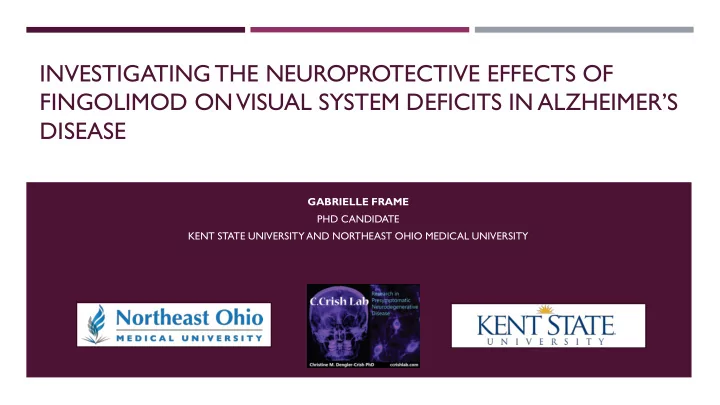

INVESTIGATING THE NEUROPROTECTIVE EFFECTS OF FINGOLIMOD ON VISUAL SYSTEM DEFICITS IN ALZHEIMER’S DISEASE GABRIELLE FRAME PHD CANDIDATE KENT STATE UNIVERSITY AND NORTHEAST OHIO MEDICAL UNIVERSITY
ALZHEIMER’S DISEASE Progressive neurodegenerative disease Hallmark pathologies Amyloid beta plaques Hyperphosphorylated tau (ptau) Neuroinflammation Deficits in memory, cognition, emotional regulation, and speech Institute for Protein Design, University of Washington
ALZHEIMER’S DISEASE AND VISION Alzheimer’s disease pathology has been shown to occur in the retina and precedes accumulation in the brain and associated cognitive deficits Patients with Alzheimer’s disease often report visual deficits prior to AD diagnosis, however, these symptoms are usually attributed to general aging Decreased visual acuity and deficits in contrast sensitivity The visual system is an attractive target for early detection of AD given the ability to non-invasively visualize and monitor it over time
WHY SHOULD WE CARE? Currently, no disease-modifying treatments are available, with research focusing on methods for early detection and disease management ~6 million Americans currently affected 6 th leading cause of death in the US Only top 10 cause of death in the US without intervention available Alzheimer’s diseases robs people of their independence and drastically reduces their quality of life as the disease progresse s Visual deficits only further exacerbate these effects, but also prevents otherwise healthy individuals from completing essential day to day tasks In patients with both Alzheimer’s disease and visual deficits, symptomology of Alzheimer’s disease may be exacerbated as pati ents struggle to recognize faces and navigate the world around them
AIM 1: OPTIMIZATION OF METHODS FOR IN-VIVO DISEASE DETECTION AND MONITORING
1 - RE: 50cd/m² 1 - RE: 50cd/m² PATTERN ELECTRORETINOGRAM 1.1.4.B 1.1.3.A 3-month male 3xtg 5µV P1 2 - LE: 50cd/m² 1.1.5A N1 N2 5µV 100ms 2 - LE: 50cd/m² 9-month male 3xtg P1 1 - RE: 50cd/m² 2.1.3A N1 N2 5µV 100ms 14-month male 3xtg P1 1.1.3A 5µV N1 N2 5µV 100ms 2 - LE: 50cd/m² 5µV
PATTERN ELECTRORETINOGRAM
IN VIVO RETINAL IMAGING • Injected 1.5 μ L of anti- amyloid beta conjugated to Alexa Fluor 488 (Santa Cruz, sc28365 AF488) • Imaged using Micron IV from Phoenix Technology Group
AIM 2: DETERMINING FINGOLIMOD’S EFFICACY AS A NEUROPROTECTIVE AGENT
THERAPEUTIC STRATEGIES FOR ALZHEIMER’S DISEASE Proposed therapy Current therapies (disease-modifying) (non-disease modifying) Acetylcholinesterase Inhibitors (AChEIs) Immunomodulator Prolong action of acetylcholine at the synapse Fingolimod NMDA receptor antagonist Currently used for treatment of multiple sclerosis Reduces calcium influx; protective against glutamate toxicity Reduces inflammatory responses Mood stabilizers Activator of protein phosphatase 2A (PP2A)
RETINAL GANGLION CELL FUNCTION AFTER FINGOLIMOD TREATMENT A B CTB Brn3a High magnification images of a 6-month-old 3xtg female mouse retina showing (A) an example of colocalization of CTB and Brn3a-positive cells and (B) and Brn3a-positive cell with no colocalization of CTB.
AXONAL TRANSPORT AFTER FINGOLIMOD TREATMENT Representative images CTB coverage in the superior colliculus of fingolimod and vehicle treated 3xtg mice (female, 6 months).
CORTICAL AMYLOID PATHOLOGY AFTER FINGOLIMOD TREATMENT
CONCLUSIONS Pattern electroretinogram recordings displayed a significant decrease in amplitude throughout disease progression, showing promise as a method for monitoring visual dysfunction associated with Alzheimer’s disease progression Demonstrated proof-of-concept of visualizing retinal amyloid beta in vivo Preliminary evidence suggests that fingolimod: may preserve retinal ganglion cell functionality after disease pathology onset in the visual system may be effective as a neuroprotectant against cortical amyloid pathology
FUTURE DIRECTIONS Chronic administration of fingolimod to an amyloid dominant Alzheimer’s mouse model Characterize various components of immune response (microglia, inflammatory cytokines) following fingolimod administration Behavioral and cognitive testing of fingolimod- treated Alzheimer’s mice Further optimization of PERG recordings for various Alzheimer’s mouse models
ACKNOWLEDGEMENTS Dr. Christine Crish Dr. Matthew Smith Katie Bretland Emily Simons Li Lin
QUESTIONS?
METHODOLOGY
PATTERN ELECTRORETINOGRAM Preparation of mice Dark-adapted for 1-hour prior to recording • Anesthetized with ketamine/xylazine (i.p.) • Pupils dilated with 1% tropicamide • PERG response measurement using Diagnosys Celeris system Mice were placed on the apparatus • Electrodes for stimuli and reference were oriented to each eye as described in Figure 1 • Black and white bar pattern stimuli presented at spatial frequency of 0.155 cycles/degree and a luminance of 50 cd/ 𝑛 2 • 600 sweeps were recorded for each eye; then averaged values for amplitude and latency of P1 and N2 were computed •
IN VIVO RETINAL IMAGING Intravitreal injections of fluorescence-tagged amyloid antibody Mice anesthetized with 2.5% isoflurane • 1.5 µL of anti-amyloid beta conjugated to Alexa Fluor 488 (Santa Cruz, sc-28365 AF488) was injected into vitreal chamber of • eye via a Hamilton syringe using 33G needle Mice were allowed to recover for 4-48 hours prior to retinal imaging • Retinal imaging with Micron-IV ophthalmoscope (Phoenix T echnology Group) Mice anesthetized with ketamine/xylazine (i.p.) • Pupils dilated with 1% tropicamide • Mice placed into holding frame and ophthalmoscope was positioned on eye • Images were focused around the optic disc for consistency between animals • Both antibody-injected eyes and un-injected eyes were imaged under white light and fluorescent 488 channel. •
CTB INJECTIONS AND TISSUE COLLECTION Intravitreal injections of 1.5 µL 0.1% cholera toxin B conjugated to Alexa Fluor 488 (CTB) were administered to each eye After 48 hours, mice were transcardially perfused with PBS and 4% paraformaldehyde Brain, retina, and ON were dissected and post-fixed Coronal sections (50 μ m) of brain tissue were taken through midbrain on a freezing microtome for assays
MICROSCOPY AND ANALYSIS Superior colliculus (SC) sections were imaged for CTB on a Zeiss Axio Imager M2 microscope Percent area fraction of label across SC area from each image was quantified for each label using a custom-written macro on ImageJ (Dengler-Crish et al., 2014) Analysis of Brn3a/CTB colocalization involved generating a z-stack of images throughout a section of tissue which was then compressed into a single image Images were analyzed by looking for colocalization of signal from the two channels used z-stacked images were utilized if there was a question whether there was true colocalization of CTB and Brn3a or if the colocalization seen was due to compression of the image
Recommend
More recommend